#critical race studies
Explore tagged Tumblr posts
Text
Black Atlantic — from Paul Gilroy: a cultural and political space formed by the transatlantic slave trade, where Black identity is shaped by oceanic movement between Africa, the Americas, and Europe; a diasporic map of memory, music, resistance, and survival. utilizes the imagery of the slave ship to demonstrate the position of Black people between two (or more) lands, identities, cultures, etc. which is unable to be defined by borders. for more, see: the slave ship
#definitions#paul gilroy#black atlantic#atlantic ocean#water#transatlantic slave trade#diaspora#england#sociology#cultural studies#anthropology#africana#history#critical race studies#guyana#in between#borders#the slave ship
8 notes
·
View notes
Text
…the rejection of “theory” itself by juxtaposition with “history,” a peculiarity in some of Hanegraaff’s recent work, is perhaps the most puzzling of all. The argument is again intimately tied to the emancipatory agenda of the rejected knowledge model: the worry is that coming to, or even selecting, the material with an explicit theoretical framework in mind will end up looking only for specific things with the end result that sources not considered relevant will once again “disappear.” The problem with this argument is that there is only one alternative to departing from explicit theorizations, namely, departing from implicit, hidden, or even unrecognized ones. One does not have to be a “radical theorist” to make the point that all scholars, no matter how big the pretention of meeting the world with a “theory-free” open mind, carry with them assumptions about what is relevant and what is not prior to even selecting one’s sources. It is a basic epistemological point recognized from the hermeneutics of Gadamer in the humanities to the post-positivism of Popper, Quine, or Kuhn in the natural sciences. The rejected knowledge model, as I have argued, appears to come with heavy layers of unexamined theoretical baggage about what “esotericism” is (what are its sources), which versions of it are relevant in the first place (who speaks for it), and how it ought or ought not to be studied (methods, research questions, analyses). If those unreflective assumptions lead to a suspicion of theoretical reflection in general, and a rejection of certain lines of theorizing in particular, we are at risk of creating an insular field. While the rejected knowledge model had sought to strengthen the legitimacy of the field, it is precisely that wider legitimacy that is at stake if the inflated version of the model takes hold. We should not reject theory to save our sources from oppression; what we need is more sophisticated and systematic theories in order to select and understand them better.
– Egil Asprem, “Rejected Knowledge Reconsidered: Some Methodological Notes on Esotericism and Marginality” in New Approaches to the Study of Esotericism (2021) Link
#Egil Asprem#Rejected Knowledge#Stigmatized Knowledge#Critical Theory#Walter Benjamin#Esotericism#gender studies#critical race studies#CRT#Frankfurt School#postmodernism#Neo-Marxist#⚒️#History#Karl Popper#Wouter Hanegraaff#Willard Van Orman Quine#Analytic Philosophy
2 notes
·
View notes
Text
Why was Killmonger so relatable?
With the social climate being as it is, I feel the need to share a small analysis that I had written in 2018 regarding the Marvel superhero movie Black Panther, it’s villain Killmonger, and why it seemed that numerous Black Americans held sympathy and even relatability towards the character. I have slightly edited it for the sake of better clarification, but have not added anything additional to my original message.
If you have not seen Black Panther, I highly recommend the watch, and also would like to warn you that the post below contains mild plot spoilers.
As you read, I ask that you keep in mind the fundamental truth that it is possible to sympathize with and even agree with some points made by a villain while also simultaneously holding them accountable and objecting to their methods. By no means do I wish to glorify or romanticize Killmonger (nor was the intent of Marvel or Disney when they characterized him), but I would be remiss to deny the very real place in which the character was built from. The foundation in which Killmonger was based on is a very real issue within the United States that social justice and civil rights activists continue to diligently combat.
Please, do not use the character Killmonger and some people’s ability to sympathize with him as justification for anti-Blackness or to vilify important social movements like Black Lives Matter.
The thing you need to understand about people liking the character Erik “Killmonger” Stevens, despite the fact he’s the villain, is this: His character is relatable to a lot of Blacks in a lot of generations. Sadly, people getting shot is all too common in poorer Black enclaves (also commonly referred to as “hoods” or “ghettos”), and I think it’s not too far fetched to say that many Blacks in America have directly or indirectly known someone who’s been a victim to some type of violence in the hood. More importantly, all Blacks have been victims to systemic, systematic, and general racism in some way or another; not to mention the events of Ferguson and so many Blacks having been shot down by police. As such, the general situation in America with Blacks is highly tense and oppressive with Blacks still feeling shooed aside. Like Martin Luther King, Jr. once said, “a riot is the language of the unheard.” Dr. King did not agree with rioting, but he made sure to state that he would not condemn it because he comprehended why riots occurred in the first place. In comes Killmonger, a direct product of all that tension, frustration, and exasperation as well as of the inaction of others - their only justification for not reaching out to help being a blatant “well, it wasn’t affecting us, it’s not our fight”. Killmonger was faced with violence at a young age, and he continued to grow up in violence due to location (Oakland) as well as the color of his skin. At a certain point, people become numb to violence like it’s second nature. You can get so numb that everything except for your desire to survive, even your morals and integrity, get tossed out the window. Preservation becomes your only goal for life, and as such you’re willing to sacrifice absolutely everything for it. Killmonger’s story is close to home for a lot of Blacks because he symbolizes that hopelessness, bitterness, and defeated feeling that many Blacks are faced with. His intention was not from a place of evil, he wanted Blacks to be able to rise up like a phoenix from the ashes. However, his methods are what damned him and even more damning was the fact that he had been so numbed from violence that he became just like his own oppressors. Violence is a circle like that. Despite Killmonger being the villain, it is imperative to recognize that T’Challa, to some degrees, came to a place of agreeing with some of his message. He recognized the validity in Killmonger’s mission, which is what led to his internal conflict and to him questioning the tradition of Wakanda. It is a vital part of Black Panther that the characters and audience recognize exactly what Killmonger was, and what T’Challa ultimately realized: We create our own monsters. Think about that the next time you criticize events like Ferguson or the Black Lives Matter movement - in which it should be noted that those were not violent, but some violent individuals took advantage of and used the movement to claim legitimacy. That, however, is a conversation for another time. Think about that the next time you try to justify inaction and disinterest with ‘it doesn’t affect me’. “In the End, we will remember not the words of our Enemies, but the silence of our Friends.” - Martin Luther King, Jr.
In rereading my own analysis, I would like to revisit the complexity of villainy presented within Black Panther to point out that, while it is understood by viewers that Wakanda is the heroic and shining example, the film places both Wakanda (particularly the Wakandan nobles in power) and Killmonger in a grey area. Returning to the point within my original analysis, T’Challa recognized the harm of Wakanda’s and his father’s inaction with the problems that African and Black diaspora face. It is this realization that Killmonger has valid arguments and valid anger that leads into T’Challa’s understanding that Wakanda must undergo social and political change.
T’Challa actively expresses his disappointment in his father and in the Wakandan government, acknowledging the pain and suffering that his country contributed to with the decision to remain passive and “neutral”, at best, or toxically self-preserving, at worst.
All in all, I would go so far as to claim that Black Panther is an exceptional example of the complexity of humanity as well as serves an important reminder that sometimes villainy and heroism are not clear-cut black and white.
#author's note#pop culture analysis#long post#black panther#killmonger#erik killmonger#erik stevens#mcu#marvel cinematic universe#social justice#race relations#blm#black lives matter#marvel characters#critical race theory#critical race studies#black culture#black history#african american studies#substack saw it first#op ed#opinion post#writeblr
5 notes
·
View notes
Text
Of course YOU don't think anything is racist when you benefit from the racism.
2 notes
·
View notes
Text
I remember learning this from the tv show “How the States Got Their Shapes.” I was just a kid at the time, so I didn’t understand the significance of it. But like the guy above me says, this is why we need CRT in school.
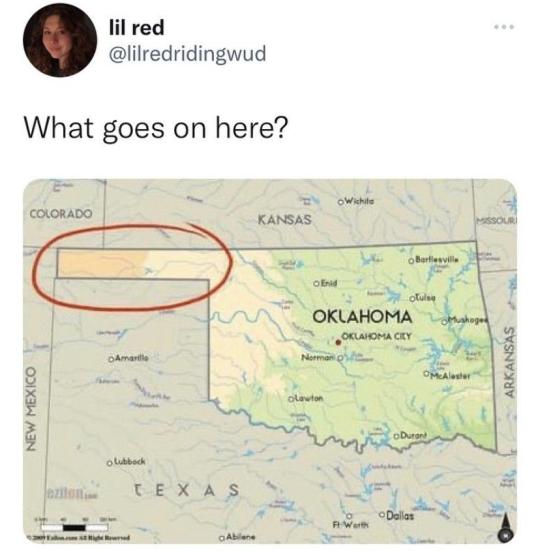
154K notes
·
View notes
Text

all incomplete - stefano harvey and fred moten
#critical race studies#black studies#thinking about this a lot as i'm in a weird limbo position wrt institutions#this book gave me a burst of life and a will to study when i felt undone#hoping maybe a reread will do the same
1 note
·
View note
Text

Artist Jonathan Harris and his painting titled “Critical Race Theory"
It’s a hauntingly effective image. A blonde figure stands, back to the viewer and paint roller in hand, covering up the images of Martin Luther King Jr., Harriet Tubman, and Malcolm X with strokes of white paint. Critical Race Theory (2021) has been embraced as a powerful reminder of the importance of teaching and preserving Black history.
The canvas is the work of Detroit artist Jonathan Harris, who, since taking up painting full time nearly four years ago, has dedicated himself to making work expressing his lived experience as a Black man in the U.S. Critical race theory, which examines the ways in which racism is embedded in our nation’s legal systems and policies, has been circulating in academic circles since the 1970s. But it began making headlines, especially in conservative media, in 2022 as some local lawmakers sought to proactively ban its teaching.
#news.artnet.com#reddit#pics#aacool#sarah cascone#martin luther king jr#mlk#dr martin luther king jr#blm#critical race theory#history#american history#black history month#black history#read#art#harriet tubman#malcolm x#2021#2020s#painting#painter#artist#teaching bans#study history#us politics#jonathan harris#keep thinking#keep reading#don't allow others to control what you learn
195 notes
·
View notes
Text

Black Studies - Emory Douglas, from The Black Panther (newspaper), c1970
"We Want Education for Our People That Exposes The True Nature Of This Decadent American Society. We Want Education That Teaches Us Our True History And Our Role in the Present-Day Society. We believe in an educational system that will give to our people a knowledge of self. If a man does not have knowledge of himself and his position in society and the world then he has little chance to relate to anything else."
(No5 from The Black Panther Party Ten-Point Program of October 15, 1966)
PDF archive of The Black Panther news:
135 notes
·
View notes
Text
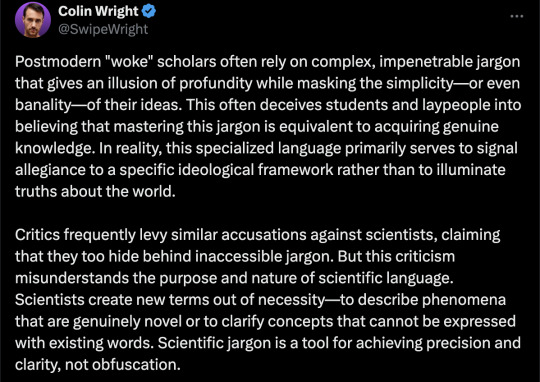

youtube
https://www.merriam-webster.com/dictionary/specious
1 : having a false look of truth or genuineness : sophistic specious reasoning 2 : having deceptive attraction or allure 3 obsolete : showy
--
Noam Chomsky: If you look at what's happening, I think it's pretty easy to figure out what's going on. I mean, suppose you are a literary scholar at some elite university. Or, you know, anthropologist or whatever. I mean, if you do your work seriously, that’s fine, you know. But you don’t get any big prizes for it.
On the other hand, you take a look over in the rest of the university and you’ve got these guys in the physics department and the math department and they have all kinds of complicated theories, which of course we can’t understand, but they seem to understand them. And they have, you know, principles and they deduce complicated things from the principles and they do experiments and they find either they work or they don’t work. And that’s really, you know, impressive stuff.
So I want to be like that too. I want to have a theory. In the humanities, you know, literary criticism, anthropology and so on, there’s a field called theory. We’re just like the physicists. They talk incomprehensibly, we can talk incomprehensibly. They have big words, we’ll have big words. They draw, you know, far-reaching conclusions, we’ll draw far-reaching conclusions. We’re just as prestigious as they are.
Now if they say, well look, we’re doing real science and you guys aren’t, that’s white male, sexist, you know, bourgeois or whatever the answer is. How are we any different from them?




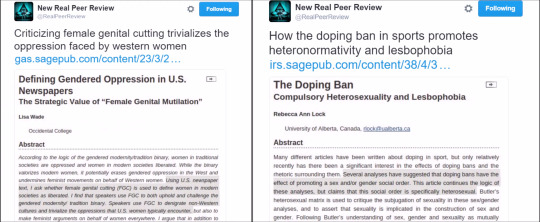
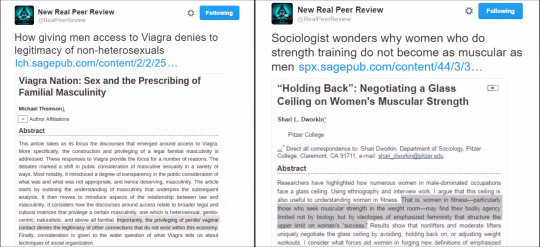
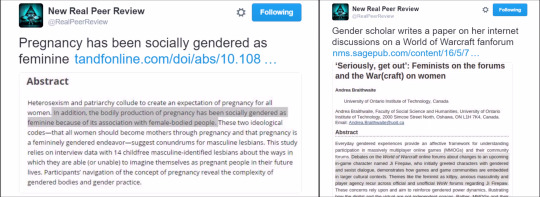
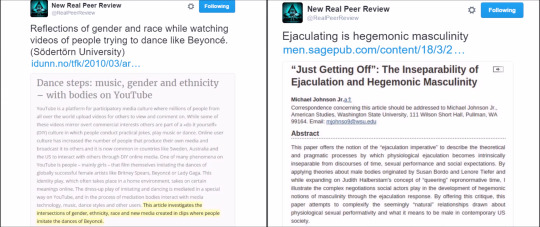
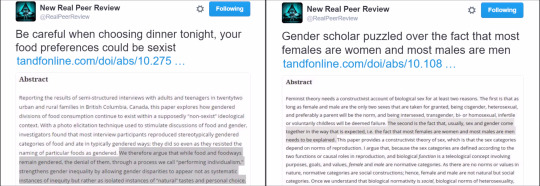



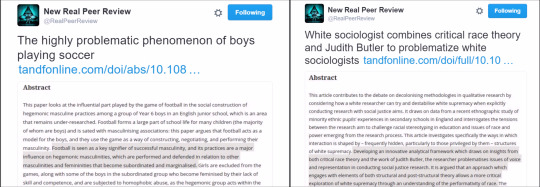
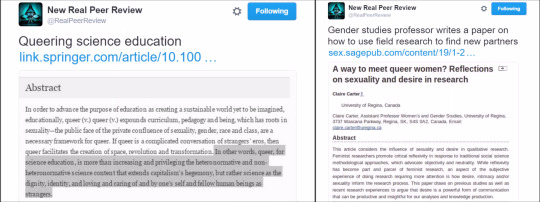

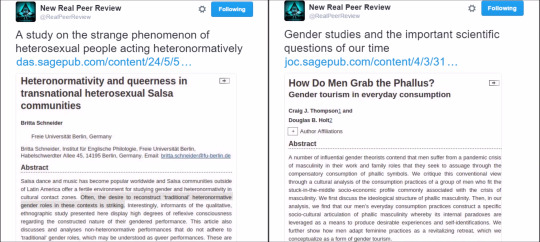
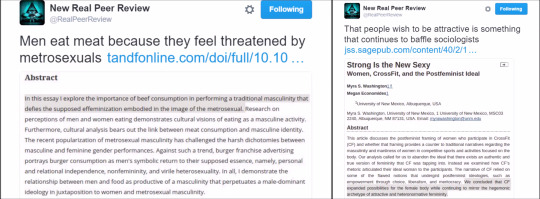
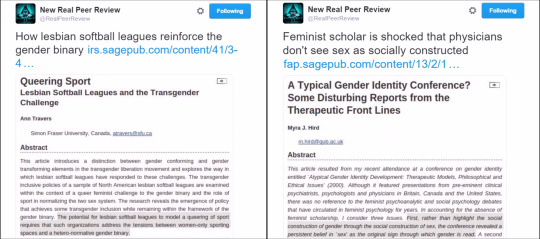
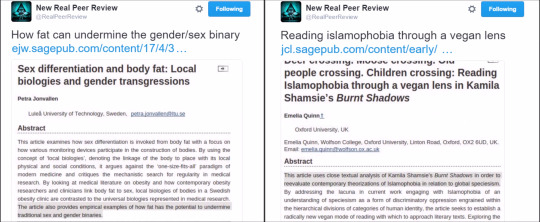
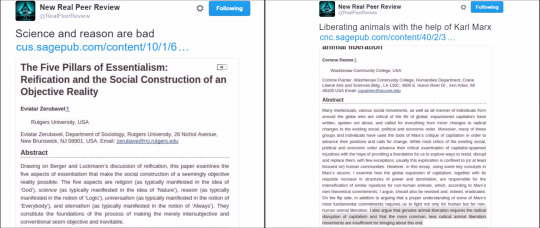
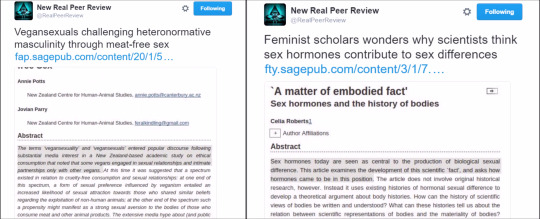
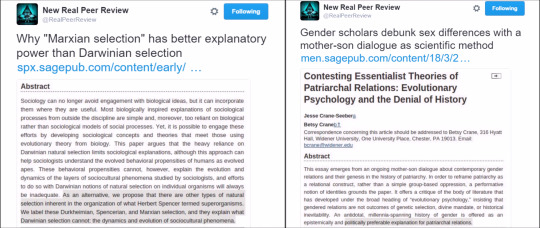

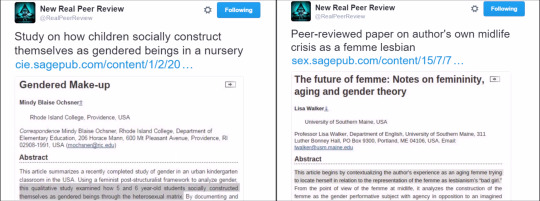
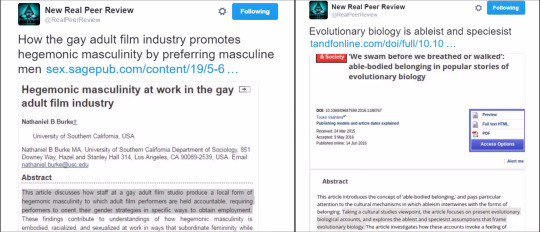
==
I worry that when I describe this idiocy as "fraud," people think I'm exaggerating, being hyperbolic or otherwise overstating it.
I'm not. If anything, I'm understating it.
All of this postmodern crap we're dealing with is completely fake. All this ridiculous intersectional jargon is a big grift. All of these domains producing this ridiculous nonsense are bogus and corrupt. All the scholarship they produce is fraudulent. It's fake from top to bottom.
All of it.
These people are cloaking asinine retardation in fancy words to cover up how asinine and retarded this asinine retardation is.
The people producing it are shallow and stupid. Not to mention, envious and spiteful about the status and authority of science. They just use absurd jargon to hide that fact and trick you into thinking it's too deep and profound for you to understand. But when it's decoded into simple English, à la the Tweet summaries above, the retarded, moronic nature becomes obvious.
The response to this kind of ridiculous shit needs to be laughter and derision, not tenure or a tertiary qualification.
We have to get rid of it because it's destroying our societies.
#Colin Wright#postmodernism#woke doctrine#feminism#feminist theory#woke nonsense#social constructivism#academic fraud#defund gender studies#gender studies#academic corruption#critical theory#critical race theory#intersectionality#intersectional feminism#patriarchy theory#patriarchy#science#what science is#religion is a mental illness
69 notes
·
View notes
Note
Hey Professor! What are some things someone should know before they go to law school?
You should know that law school is centrist-liberal brainwashing school, and prepare for it! The cultural mindset promoted by law school make you less radical, and it’s easy to fall into the trap if you’re not constantly vigilant about it.
I highly encourage anyone who goes to law school to read Mari Matsuda’s When the First Quail Calls: Multiple Consciousness as Jurisprudential Method and actively cultivate multiple consciousness so that you can learn the language and logic of legal practice without losing your radical and critical abilities. Few texts have had a greater influence on me, and it’s only 4 pages!
168 notes
·
View notes
Text
…the emancipatory agenda of countering “rejected knowledge” appears to have moved much beyond historicizing how the category was initially shaped in a polemical context, to now also identify an increasing number of contemporary academic approaches, schools, and theoretical traditions as inherently “anti-esoteric.” From the early polemic against “reductionist” approaches, recent publications show a worrying fixation with labels such as “neo-Marxism,” “Critical Theory,” “the Frankfurt school,” and “postmodernism,” sometimes apotheosized into an attack on “theory” as such. “Neo-Marxist” critical theory tends to be implicated directly in a continued rejection of esotericism, often by quoting Adorno’s famous “Theses against Occultism”. This, however, tends to come at the expense both of a more nuanced historical understanding of how early critical theory in fact related to “esotericism” (the case of Walter Benjamin’s esoteric fascinations being the most obvious counterpoint), and by underplaying the real concerns of “Frankfurt School” critics’ diagnoses of modern capitalist society. The problem is that the historical analysis of how certain scholars influenced the conceptual history of esotericism becomes conflated with a polemic against contemporary perspectives on, for example, critical theory. This is particularly unfortunate seeing how important critical theory is for a whole range of approaches that the study of esotericism sorely needs to engage with in order to refine its perspectives, from gender studies and critical race studies to postcolonial and decolonial theory and issues of class. Excluding those perspectives and dismissing colleagues who work with them can only lead to further theoretical isolation of the field itself.
– Egil Asprem, “Rejected Knowledge Reconsidered: Some Methodological Notes on Esotericism and Marginality” in New Approaches to the Study of Esotericism (2021) Link
#Egil Asprem#Rejected Knowledge#Stigmatized Knowledge#Critical Theory#Walter Benjamin#Esotericism#gender studies#critical race studies#CRT#Frankfurt School#postmodernism#Neo-Marxist#⚒️
2 notes
·
View notes
Text
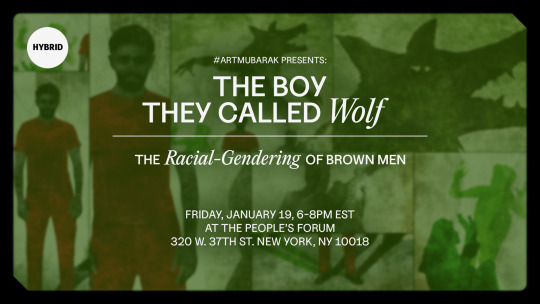
THE BOY THEY CALLED WOLF: THE RACIAL-GENDERING OF BROWN MEN
We are witnessing the horrific genocide of Palestinians in real-time, with watchdog groups around the world denouncing Israel’s siege and urging for ceasefire and humanitarian aid. But notably absent from the discussions around relief are Palestinian and more broadly Arab and brown men and boys.
Brown womenandchildren are subject to a default perfect victimhood, whereas the brown man is already dangerous, killed for his “yet-to-be-committed errors.” The “womenandchildren” framing assumes that brown men are less worthy of life, that it is not also a horror to slaughter our brothers and fathers and husbands.
This event outlines the myriad ways in which brown men are subjected to Orientalist depictions such as hypersexual, savage, and brutish, and examines how these caricatures serve to dehumanize brown men and justify their maiming and extinction. We will also explore brown men in relation to brown women and marginalized genders, and what constitutes the “perfect victim” in the eyes of the colonizer.
Friday, January 19, 6-8PM EST The People's Forum 320 W. 37th St., New York, NY 10018
RSVP here!
This event has a hybrid option for those unable to attend in-person.
#palestine#critical race theory#gender studies#orientalism#the people's forum#queer theory#intersectional feminism#please come. rare celicalms public appearance
108 notes
·
View notes
Text
Mixed and Matched
All of the issues going on in America has me especially thinking about my personal identity and my role within the world. I also want to express that this post has a lot to do with an episode of a show on Netflix, Ginny & Georgia.
I am biologically Black ADOS (American Descendant of Slavery), Asian, Native American, and White. I have the privilege of being light-skinned as well as somewhat racially ambiguous, and so I want to begin this post by acknowledging these privileges and stating that I do not, will not, and cannot speak for other people of color. I can only speak on my own experiences and my own perspective based upon those experiences.
For those who have yet to see Ginny & Georgia, the general plot revolves around a White mother from the South named Georgia, her biracial Black and White daughter Virginia nicknamed Ginny, and her White son Austin when they move into the New England community of Wellsbury.
Before I go any further, I want to make it very clear that there will be big spoilers for the Netflix Original Series: Ginny & Georgia: S01 E08 “Check One, Check Other.”
As is expected with a titular biracial heroine, Ginny’s biraciality is a key aspect of her character and a focal plot point as she navigates living in a primarily White high school. Much to Ginny’s chagrin, she quickly understands that racism and racial bias is not restricted to the southern United States and makes an enemy of her problematic literature professor. Ginny is not the only biracial narrative we encounter, however, as we soon meet the character Hunter and are given the perspective of a half Taiwanese male when the two characters begin a romantic relationship.
Without giving too much away, I will disclose that their relationship is not exactly an ideal one due to a third party, but I am choosing to ignore the romantic love triangle arc as a whole to instead just focus on the relationship of Hunter and Ginny without acknowledging the problematic love triangle within the show.
Very early in the show’s narrative, we are introduced to racial stereotypes such as “smart Asians” in the way that the literature professor, Gitten, constantly praises Hunter’s academic prowess while simultaneously refusing to acknowledge Ginny, the only Black individual in his class, as being at least equally as intelligent as Hunter. Not only this, but Gitten also takes every possible opportunity to single out Ginny when it comes to talking about problematic racist rhetoric within classic (i.e. White-centered) literature. While Gitten does not seem to give Ginny unfair grades, he absolutely refuses to express her capabilities to the rest of the class while freely holding Hunter on a pedestal as his star student.
This comes to a head when the class is given an essay assignment explaining the place that they feel they most belong, in which was part of a national competition. Ginny, worried about her lack of extracurriculars for college applications, takes it upon herself to aim to win. After some time soul-searching with her father and being exposed by him to slam poetry, Ginny decides to submit a poem in lieu of an essay.
Ginny’s poem transcript:
Growing up, I thought people were born with their heads cocked because that’s how they always looked at me. Boxes. Check one, check other. People don’t know, they don’t furrow between the layers like I do. They don’t switch and twitch and actively make the decisions of which. Which part of me belongs today, which aspect of my personality will offend the least and blend the most and work and succeed and bury the lead like a switchboard of traits that decide my fate and I’m always an imposter. Always lost, always asking for directions and people point my way like the scarecrow. Like tornadoes blowing me whichever way the wind blows. Well, Dorothy doesn’t want to play today, she’s prepping for the SAT. Just the scantron. The box is empty and glaring and daring me to choose one. Well, I’m an expert at boxes. My whole life can fit inside it and I’ve got it down to a science. I can pack my entire identity in an hour because where there’s roots, there’s power. But I’m all top soil. My blood runs like water and oil refusing to stick. My dad’s old books, read in secret nooks. That camera that locks all my memories in a flash, saved for when my recollection doesn’t last. That lighter that sparked that fire. All fit in a box ready to be carried from door to door, but that’s not the kind of box people ever ask for. So many lines in the sand, so many “can’t”s and “can”s. I see both worlds so clearly, and I skip and jump and dance and fall between, never seen. I belong in the spaces between. Check all that may apply.
While Ginny’s poem was incredibly well received by her classmates, it came as no surprise after the set-up tension between Ginny and her professor Gitten that Ginny would not be announced the winner within her class. The conversation between Ginny and Hunter later at her house stems greatly from Ginny’s belief that she had been cheated out of winning the contest due to racism.
It is then that the complex histories and interracial relations between Asians and Blacks as a whole unveils itself through both characters, both biracial people of color who suffer from not feeling “enough” as well as attempting to navigate the complexities of racial stereotypes and the problematic idea of racial hierarchies. Furthermore, it was not surprising when Hunter was chosen as the winner. The purpose of this post is not to argue if Gitten was justified in his decision or even if Gitten was racist, however, so I will opt not to venture into that controversy. Instead, we will focus on what Ginny and Hunter say to one another that leads to their separation.
Argument scene transcript:
Ginny: I should have won. Gitten's so clearly being racist. Hunter: Uh… Ginny: You don't think I deserved to win? Hunter: Your piece was impactful. I loved it. Trust me, I get it, but the assignment was to write an essay, and you didn't do that. It was unconventional. Ginny: You're siding with Gitten right now? Are you serious? Hunter: I'm just saying if you're so concerned about him and what he thinks about you, why are you always causing drama in his class? Ginny: I have to speak up because I'm a person. I have a voice. Hunter: Okay. Ginny: You're an artist. You should get this. Hunter: Yeah, exactly. I didn't do a song. It's all about survival. I keep my head down. I do the thing that's asked. Ginny: And you're proud of that? Hunter: Why can't I just be who I am? Ginny: Because you're half Taiwanese. Hunter: Exactly. I'm not full White, so Gitten can't be full racist. Ginny: Not in the same way I'm not full white. Asians get to be stereotyped as talented geniuses and prodigies, okay? Black women are… are stupid, lazy, angry. Brodie doesn't fist-bump you. Hunter: Do you know what it means to be Taiwanese? I have to serve in the military when I turn 19 because I'm a guy. Or I can relinquish my citizenship because I'm lucky I'm also American. But then I'm a draft dodger and just another soft American p*ssy. When I went to Taiwan, I thought, "Wow. Finally, my people." But it was just this hard reality check that, "No, you don't belong here either." You have no idea what it's like for me. I'm sorry. Does that not fit with me being the cool guitar guy? I worked really hard on my essay, and I followed the rules. Ginny: You really think that if I'd followed the rules, I could've possibly won? You don't get it. You are closer to white than I'll ever be! Hunter: Together we make a whole White person! Ginny: Your favorite food is cheeseburgers and I know more Mandarin than you do, you’re barely even Asian! Hunter: Sorry I’m not Chinese enough for you. But I’ve never seen you pound back jerk chicken. Last time I checked, Brody twerks better than you. And I liked your poem, but your bars could use a little more work, homie. So, really, how Black are you then? Ginny: Excuse me? Hunter: What? Literally, What? Because if we’re gonna play that game, let’s do it. Oppression Olympics. Let’s go.
Firstly, I want to address exactly what Twitter addressed when this scene from Ginny & Georgia first began trending: the scene is rather cringe-inducing. It felt inorganic simply because the show writers did not do enough characterization and build up for this scene to feel like anything more than the means to an end of the characters’ relationship. Essentially, the scene just felt like a plot point afterthought for Ginny to be free to explore the third in their love triangle rather than an actual intent to have the hard exploration and discussion of race politics and historically strained interracial relations in America.
Not only that, but Ginny & Georgia tends to dance back and forth between deciding how to depict Ginny dealing with her race and how Black people are treated in the United States. For example, at beginning of the series, Ginny expresses distrust in the police, but, later in the series, there is no consequence for her White mother calling the police on her biracial Black daughter and allowing her to be arrested. For context, Georgia called the police to make a noise complaint when she discovered that Ginny had snuck out to have a party with her friends across the street. Upon arriving, the police arrested the teenagers and Georgia simply listened as her boyfriend detailed watching the police place a drunken Ginny into the back of a police car. Not only that, but Georgia refuses to go save Ginny, leaving Georgia’s boyfriend to make the decision to (without Georgia’s permission) bail Ginny out and bring her home. The trauma of that situation for Ginny as a Black girl is never addressed and Georgia is never held accountable for purposely putting her daughter in such a situation.
Netflix and the show writers basically just pick and choose when it’s convenient to remind viewers of non-White raciality and then retreat into color blindness when raciality no longer serves a purpose of justification to tension. For people of color in the real world, this tension from raciality can never just be turned off and on, it is consistently always on. But, I digress…
All of that said, it should be acknowledged that arguments like this are not non-existent and happen a bit more frequently than people might notice or like to admit.
In light of the shooting in Atlanta, Georgia that resulted in the death of 6 Asian American women (as is confirmed thus far), fear and outrage sparked as anti-Asian racism reared it’s ugly head into the forefront. While the issue is one familiar to all Asian Americans, the concept has unfortunately taken some by surprise enough to make even other people of color question: has anti-Asian racism risen recently or has it always existed?
As a mixed Asian American woman, I find the very question and it’s implication offensive. My offense aside, however, I would like to state that my stance and answer to the question is both.
Anti-Asian racism reaches back to the Gold Rush when an influx of Asian, most notably Chinese, gold miners immigrated to America an an attempt to achieve wealth just like their European counterparts. Of course, one could also go back into history much further to when Europeans first “discovered” Asia, but to keep things more simple, I will opt to only speak about anti-Asian racism within the United States.
Anti-Asian racism has persisted throughout history, some examples including but not limited to:
1854 People v. Hall which established that Asians had no rights to testify against White citizens. To note, during the 1800s, anti-Asian racism was primarily directed towards Chinese individuals and anyone that was perceived as Chinese.
Anti-Coolie Act of 1862 in which Asian immigrants were forced to pay a monthly tax to run businesses in California.
Naturalization Act of 1870 which allowed naturalization for Blacks and Africans, but denied citizenship to Asians as well as denied the immigration of Asian women.
Chinese Massacre of 1871
Page Act of 1875 was an immigration law in which Chinese women were denied entry into America as a means of “population control”.
1878 In Re Ah Yup Case in which Asians were ruled unfit for participation in government and thus ineligible for naturalization.
1879 Constitution of California in which Chinese employment became strictly prohibited.
Chinese Exclusion Act of 1882 passed by President Chester A. Arthur and Congress that implemented a 10-year ban on Chinese labor immigration. This also included anyone perceived as Chinese.
Geary Act of 1892, an extension of the Chinese Exclusion Act.
1885 Rock Springs, Wyoming Murders in which 28 Chinese coal miners were murdered, 15 were wounded, and Rock Spring’s Chinatown was burned to the ground.
Chinese Americans had a huge part in connecting the country through the building of the Transcontinental Railroad and were frequently given the most dangerous, fatal jobs while earning less than their White counterparts.
1900-1904 San Francisco's Chinatown Bubonic Plague in which Chinese citizens were segregated and quarantined while White citizens were allowed freedom.
1904 World's Fair Louisiana Purchase Centennial Exposition in which Filipino immigrants were placed within a human zoo.
Pacific Coast Race Riots of 1907
The Asiatic Exclusion League, also known as the Japanese and Korean Exclusion League.
1913 Alien Land Law in which Asian land ownership was restricted and then banned entirely.
Immigration Act of 1917 in which immigration from the Asia-Pacific was banned with the exception of select professionals.
1922 Cable Act in which Asians were excluded from citizenship.
1923 US v Bhagat in which it was ruled that all Hindu people were ineligible for naturalization.
1924 Immigration Act in which ass immigration from Asia was banned.
1924 National Origins Quota in which Japanese were excluded from immigration and citizenship.
1927 Lum v. Rice in which it was ruled that the exclusion of Chinese American children from school did not violate the 14th Amendment.
1933 Roldan v. LA County in which Filipinos were denied citizenship and the Anti-Miscegenation Laws were amended to forbid the interracial marriages of Filipinos and Whites.
1934 Tyding-McDuffle Act in which Filipino immigration way limited to only 50 people per year.
1937 Anti-Alien Land Law in which Filipino Americans were banned from becoming landowners.
1942-1946 Executive order of President Franklin Roosevelt that forced all Japanese people, regardless of citizenship, into Japanese Internment Camps.
1943 Magnuson Act that repealed the Chinese Exclusion Act and banned more that 105 Chinese immigrants per year.
1946 Luce-Celler Act in which Indian immigrants were banned beyond a quota of 100 immigrants per year.
1982 Murder of Vincent Chin in which the Chinese American man was beat to death with a baseball bat in Detroit after being mistaken as Japanese by two anti-Japan White men. His assailants were convicted of murder but never served any jail time.
1985–1993 Jersey City based anti-Indian and anti-Hindu hate group known as the Dotbusters
Post-9/11 Islamophobia
2001 Murder of Balbir Singh Sodhi in which the Sikh American man was profiled as an Arab Muslim by a White man on an anti-Muslim shooting spree in Mesa, Arizona.
2007 Murder of Cha Vang in which the Hmong man’s body was found in the woods near Peshtigo, Wisconsin after being shot and stabbed.
2011 Military investigation of the death of Danny Chen in which the Chinese American was found dead from a presumed death by suicide in his living quarters at the base in Kandahar province, Afghanistan. It was reported that he was subjected to extreme physical abuse and ethnic slurs and insults at the hands of his superiors and fellow soldiers.
Many Asian Americans are assumed foreign even if they speak perfect, fluent English and even if they have lived in America for generations, igniting the fear of deportation that can discourage Asian Americans from reporting anti-Asian hate crimes. Asian Americans are also frequently blown off by non-Asians if they harbor even a slightly perceived accent, often deeming them “incoherent” while the Model Minority Myth is consistently used to justify non-Asians minimizing the Asian struggle into just “complaining” rather than being actual legitimate problems.
Tension between the Black and Asian communities has occurred for what almost feels like the dawn of history and remains perpetuated by the Model Minority Myth that hyper-fetishizes Asians as the “good” and “ideal” people of color that are “honorary White” while treating Blacks, Latine, and BIPOC as the “bad” and “problematic” people of color. Essentially, the Model Minority Myth has persisted as a tool to advance White Supremacy by inciting horizontal aggression to remove White Supremacy as the focus and root to systemic racism.
I do not write about this nor focus so heavily on anti-Asian racism to discredit or minimize anti-Blackness nor will I ever deny that too many Asian Americans have internalized the Model Minority Myth and anti-Blackness. However, that does not excuse anti-Asianness any more than anti-Asianness excuses anti-Blackness.
Prior to the murders in Atlanta, the reception of Ginny & Georgia’s “Oppression Olympics” scene was not well received by critics and, more devastatingly, less well received by people of color. A quick Google search regarding the scene could bring up dozens of articles that focused on the cringe-worthy scene, but more overwhelming were the personal responses of people of color on Twitter. More specifically, from my observation, the responses of Black and mixed Black Twitter patrons who claimed that such a scenario was unrealistic and dramatized because they had never personally found themselves in such a situation.
I do not wish to invalidate those people, but I vehemently beg to differ because scenarios such as the “Oppression Olympics” scene are ones I, and likely many other Asian identifying people of color, have found myself in repeatedly during my life. Dishearteningly, majority of the critique against the scene focused on Hunter utilizing Black stereotypes and anti-Black rhetoric while Ginny’s responses laced in Asian stereotypes and anti-Asian rhetoric were ignored and unacknowledged.
In fact, the entire scene was meant to be offensive with both characters trading racist rhetoric to prove the point that being “Black enough” or “Asian enough” is a battle that neither could ever win when the very definitions utilized to describe their respective ethnicities are rooted in racial bias and racial stereotyping founded by White Supremacy. Yet, this point seems to have gone over the heads of many viewers precisely because of the unyielding societal belief that anti-Asian racism does not exist and and the subsequent gaslighting and denial of Asian struggle to reduce Asian racial struggles into simply “complaining”.
White Supremacy has tricked every person of color into the belief that oppression has only one face, one method, and one mode by insisting on the Model Minority Myth and the Black-White Binary in which our entire American socio-political society was built and continues to act on.
I feel like I have nothing more to add at the moment that would not just be a repeat of things I have already addressed, so I will instead end this post with three TikToks I have happened upon that I believe are significant to the topic.
chinforshort
theluncheonlawyer
peterperrylam
Below are some resources related to anti-Asian racism to supplement this post.
“Anti-Asian violence has surged in the US since COVID-19. But it didn't start there” by Maura Hohman
“The Muddled History of Anti-Asian Violence” by Hua Hsu
“The long, ugly history of anti-Asian racism and violence in the U.S.” by Gillian Brockell
“The history of attacks against Asian Americans is complicated. Addressing it will be, too” by Harmeet Kaur
“The long Western legacy of violence against Asian Americans” by Jane C. Hu
#author's note#substack saw it first#social justice#interracial relationships#interracial relations#black history#asian history#ginny and georgia#netflix#netflix series#netflix ginny and georgia#pop culture analysis#long post#critical race studies#critical race theory#op ed#opinion post#writeblr
2 notes
·
View notes
Text
btw not to rub more salt in the wounds, but it's worth remembering that mixed-race people in LatAm (mestizaje) all benefit, contribute, and suffer under colonial rule. Disentangling this all has been very painful, and I haven't even scratched the surface.
We've always been a part of the resistance. I think this part of dismantling demands that we follow.
#settler colonialism#book recs always welcome and I always order at my library for reading#for ex: C. Heike Schotten's Queer Terror Life Death and Desire in the Settler Colony#Joanne-Barker-(ed.)'s Critically Sovereign- Indigenous Gender Sexuality and Feminist Studies#MargaretJacobs' White Mother to a Dark Race - Settler Colonialism Maternalism the Removal of Indigenous Children in the American West
2 notes
·
View notes
Text
was a bit funny seeing someone say that the mourn watch background should only have been available to mages bcs "why would the mourn watch need warriors or rogues", when one of the most common complaints about the combat in this game is that it's hard to play a mage without a tank in the team lol
#it would be idiotic to only accept mages to the mourn watch#have you been to the necropolis that place is fucking dangerous#you need all kinds of skills to deal with the things it throws at you#the mages will need protection and support from the non-mages#also the reaper specialization makes perfect sense considering it's a form of spirit warrior and the MW has a special connection to spirits#i think it would be easy to come up with a rogue specialization too since the MW's studies focus a lot on alchemy and anatomy#besides the MW's whole thing isn't just about magic and veil stuff. they tend to the dead!#that is in fact a pretty big part of their job#LET NO WATCHER FORGET THAT OUR GREATEST TREASURY IS OUR DEAD 🗣🗣🗣#anyway i'm tired of most people looking at the game and its lore only through the eyes of an elven mage and how it would best serve them#and i understand criticizing the game but don't go looking for problems in places where there barely is any#the MW background was well-written and works with all the races and classes#vg txt
2 notes
·
View notes
Text
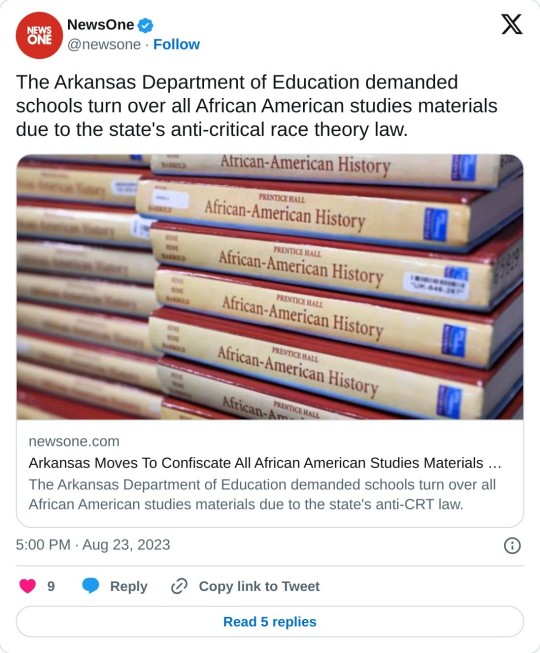
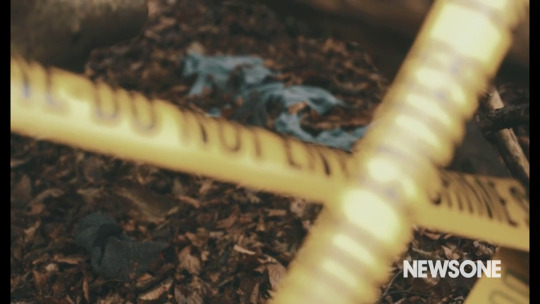
Arkansas appears to be trying to compete against Florida and Texas in the White and Fragile Red State Olympics, and, specifically, the sport of stifling Black history.
Earlier this month, we reported that the Arkansas Department of Education just up and decided two days before classes started that it would not recognize a new Advanced Placement course on African American history for course credit for the 2023-24 school year. Now, the department is demanding that every K-12 school in a six-district radius turn over all of their African American studies materials so they can be scanned for violations of the state’s anti-critical race theory law.
MORE: The Importance Of African American Studies
Related Stories
Here’s another way to put that: Arkansas and its governor, Sarah Huckabee Sanders, are out here confiscating Black history because it might violate anti-CRT standards they propagandized into anti-CRT legislation. It’s basically iron sharpening iron if both blades of iron are actually white supremacy.
But seriously, is government officials using anti-“woke” propaganda as a green light to invade places of learning and demand educational materials be turned over for inspection not exactly the kind of thing that links right-wingers to fascism? Please tell me the same people who boast that the government would have to pry their guns from their “cold dead hands”—despite no notable effort by government officials to confiscate citizens’ guns anywhere in America—are not going to stand for history books being taken by way of government overreach. (Yes, I understand that they’re public schools. No, that doesn’t make the optics any less Orwellian, not to mention racist AF.)
Ok, but let’s be fair here. After all, maybe the department has some reason to believe dangerous messages are being spread to indoctrinated school students. Perhaps schools are teaching step-by-step “kill whitey” instructions or, as conservatives often suggest, teaching Black kids to hate America and white kids ot hate themselves.
Let’s just take a look at what they’re so concerned about.
“Given some of the themes included in the pilot, including ‘intersections of identity’ and ‘resistance and resilience,’ the Department is concerned the pilot may not comply with Arkansas law, which does not permit teaching that would indoctrinate students with ideologies, such as Critical Race Theory (CRT), (See Ark. Code Ann. § 6-16-156, as amended by Section 16 of the LEARNS Act),” the letter sent out to the superintendents of the districts reads.
“To assist public school employees, representatives, and guest speakers at your district in complying with the law, please submit all materials, including but not limited to the syllabus, textbooks, teacher resources, student resources, rubrics, and training materials, to the Department by 12:00 pm on September 8, 2023, along with your statement of assurance that the teaching of these materials will not violate Arkansas law or rule. Items can be scanned and emailed to [email protected].”
Well, there you have it, good people. The Arkansas Department of Education has important work to do here! The school districts in this great state simply cannot be left to their own devices lest the children—the precious, impressionable children—be insidiously indoctrinated by horrific lessons on—God, I can hardly even say it—”intersections of identity” and “resistance and resilience.”
Again, Arkansas wants to be Florida so bad. The Sunshine (or sundown) state is requiring lessons about enslaved people benefiting from slavery, and accepting “educational” materials from PragerU, a demonstrably racist organization that teaches children that Frederick Douglass would agree slavery was a necessary evil to preserve America. Now, Arkansas is picking up the white nationalist indoctrination tiki torch by eliminating Black studies materials that teach about the “resistance” and the “resilience” of oppressed people.
This is white supremacy at work. This is exactly what critical race theory was created to examine.
SEE ALSO:
Florida Approves Teaching Students That Slaves Benefited From Slavery
Florida’s New Black History Curriculum Whitewashes Slavery, Victim-Shames African Americans, Critics Say
#Arkansas Moves To Confiscate All African American Studies Materials Over Critical Race Theory Fears#arkansas#white supremacy terrified#white lies#white lies revealed#schools#education
14 notes
·
View notes